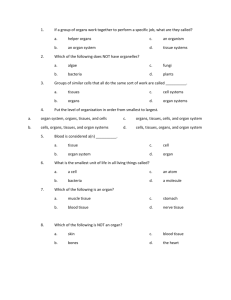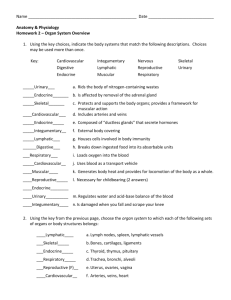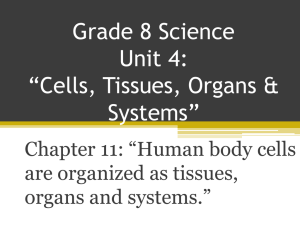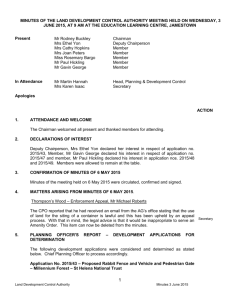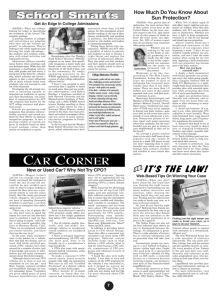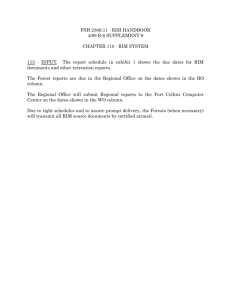LEARNING*FOCUS STRATEGIES
advertisement
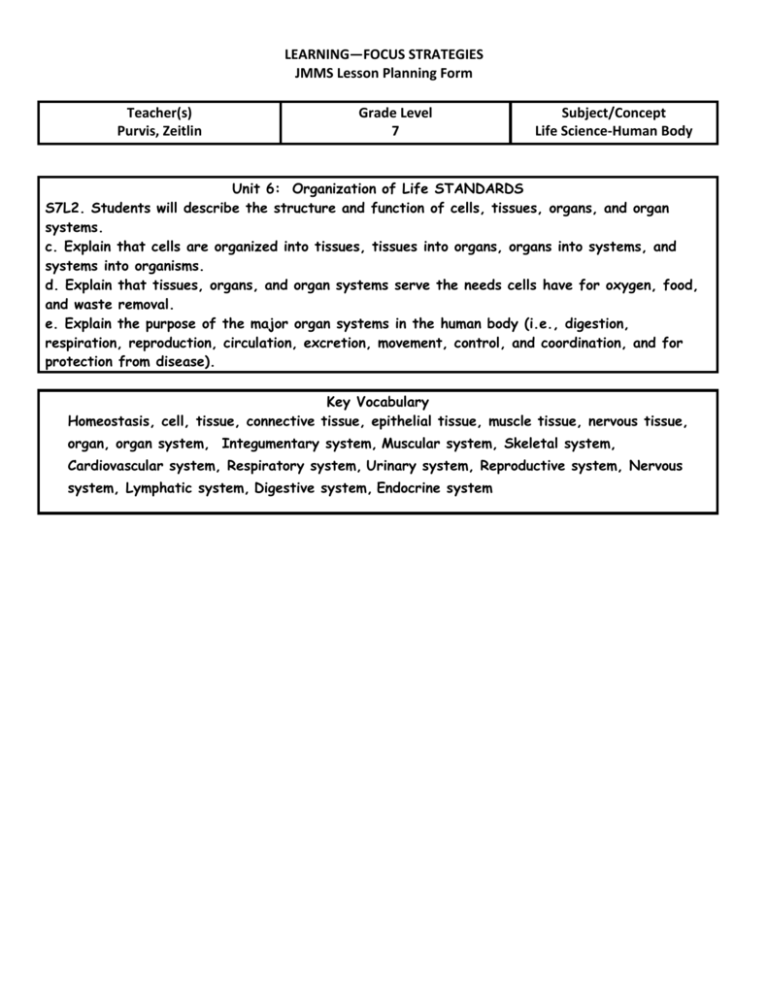
LEARNING—FOCUS STRATEGIES JMMS Lesson Planning Form Teacher(s) Purvis, Zeitlin Grade Level 7 Subject/Concept Life Science-Human Body Unit 6: Organization of Life STANDARDS S7L2. Students will describe the structure and function of cells, tissues, organs, and organ systems. c. Explain that cells are organized into tissues, tissues into organs, organs into systems, and systems into organisms. d. Explain that tissues, organs, and organ systems serve the needs cells have for oxygen, food, and waste removal. e. Explain the purpose of the major organ systems in the human body (i.e., digestion, respiration, reproduction, circulation, excretion, movement, control, and coordination, and for protection from disease). Key Vocabulary Homeostasis, cell, tissue, connective tissue, epithelial tissue, muscle tissue, nervous tissue, organ, organ system, Integumentary system, Muscular system, Skeletal system, Cardiovascular system, Respiratory system, Urinary system, Reproductive system, Nervous system, Lymphatic system, Digestive system, Endocrine system Essential Question(s) Activator: (ex: quick write, corners, wordsplash) Teaching Strategies Include Thinking Map(s) Include Guided Practice (ex. Coll. Pairs, assessment prompts, Think-Pair-Share) How do cells make tissue? What is the function of each tissue type? How do tissues make organs? What is the function of the organs? How do organs make organ systems? What is the function of the organ systems? What is the purpose of the major organ systems in the human body? How do the skeletal and muscular systems work? What are the organs and functions of the cardiovascular and respiratory systems? What are the parts of the digestive and urinary systems and how do they work? How do the endocrine and lymphatic systems work? What are the structures and functions of the integumentary and nervous systems and how do they work? Share pairs, Individual and Group Brainstorms, Show what you know, Coach questions, teacher-made quick reviews, wordsplash, quick write, Bone song, Heart activity, stomach demonstration, endocrine activity, build a lung model or human ear model. Discussion, Cornell Notes from PowerPoint, Guided Reading from textbook and CRCT Coach book, Graphic Organizers, Web Activities, handouts (EdHelper.com, CPO, teacher made), Flash cards for vocabulary words, lab activities, ActivBoard activities 1) Introduce cell unit by using a circle map. Brainstorm about body systems. 2) Video: Human Body in Action: Body Systems Interrelations 3) Students add video facts to circle map created earlier. 4) Activity: Make a flow map showing how cells are organized to make organisms. (Progression, definition, examples) CPO Science book, p. 35 5) Tissues (types) (CPO p. 368) PowerPoint Presentation “Body Organization Vocabulary” PowerPoint Presentation “Body Organization and Structure” 6) Definitions, functions, Guided Reading selections, Brainpop videos, graphic organizers, & activities for each organ system (Chart CPO p.367) 7) Make flashcards for each organ system: list definitions, functions, and organs within the system ORGAN SYSTEMS: Integumentary system (CPO p. 394) Muscular system (CPO p. 356, 412-413) Skeletal system (CPO p. 367, 408-411) Cardiovascular system (CPO p. 368-390) Respiratory system (CPO p. 391-392) Urinary system (CPO p. 397) Reproductive system (CPO p. 398) Nervous system (CPO p. 430 Lymphatic system Digestive system (CPO. p. 397 Endocrine system (CPO p. 395-396) 8) Using double-bubble maps, compare and contrast body systems. Write a summary paragraph. 9) Review for Assessment: Science Coach, Lessons 8-14 CPO Science Assessments 10) Assessment 11) Culminating Lab: Dissect a frog Summarizing Strategies (ex. The most important thing is…, parking lot, 3-2-1) Extending Thinking Task (ex. compare/contrast, classifying, constructing support) Make a Wordsplash (wordsplash.com) of some of the most important vocabulary words. Guided reading, Brainpop, Ticket out the door, 3-2-1, answering the essential question, summary sentence, “tell a neighbor” Write a creative story: You are a . . . body system. Write about a day in your life. Write help wanted advertisements for three of the organ systems. Describe what the important functions of the system are in your ad. Research “Transplant Ethics.” Should transplants happen at all? Who should get a transplant? Should a child receive a transplant before an older person? Write an editorial for a newspaper. Research facts about the food pyramid. How many calories should a person your age eat per day, per week? Create a “Healthy Menu” for a week. Include quantities and calories. Research a disease. Create an informational pamphlet about the disease. Include a website for additional information. Research prosthetic legs. Present your findings in a creative way. Technology implementation Power points , videos, Webquest, Activ studio, Activ Inspire, brainpop, Holt Virtual Investigations websites- Accommodations with student initials DG, KT, JT, CH, AF-Preferential seating; DG, JT, PP, DL, EB-explain and paraphrase directions JT, AF, PP, DL, KT, CH, EB-extra time The days required for a lesson plan are based on each concept, topic, or skill while an assignment is daily.






